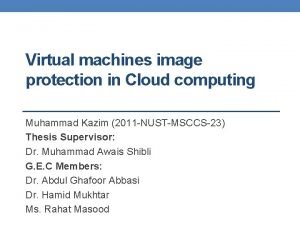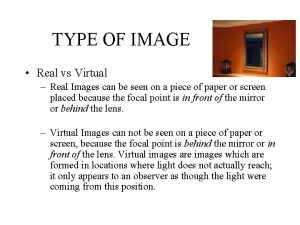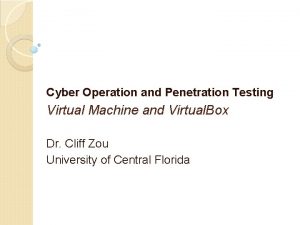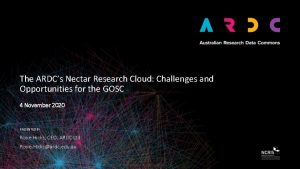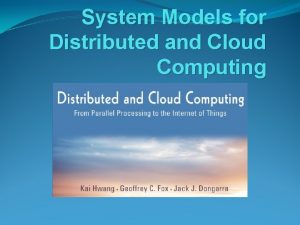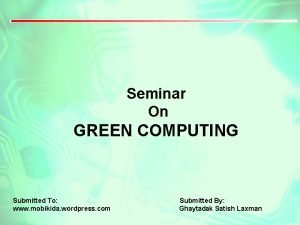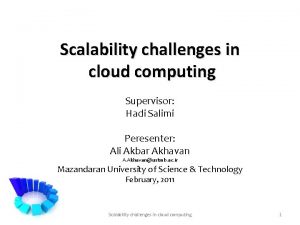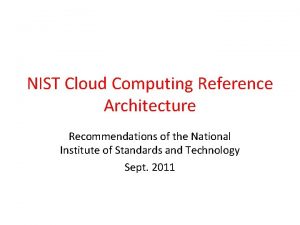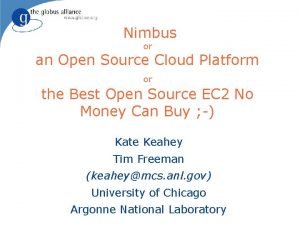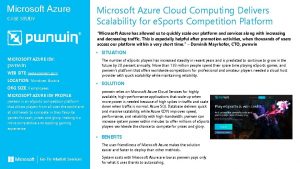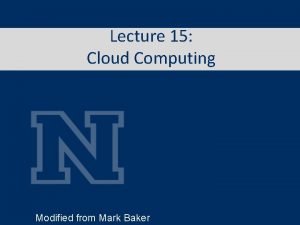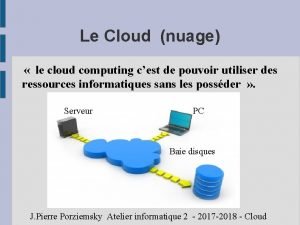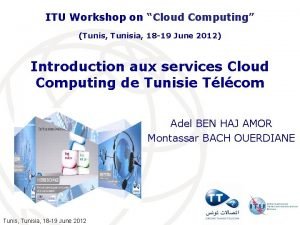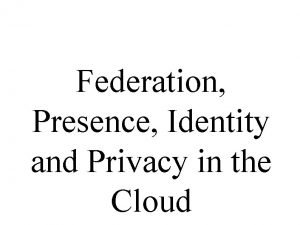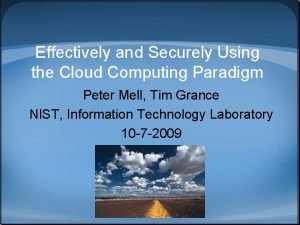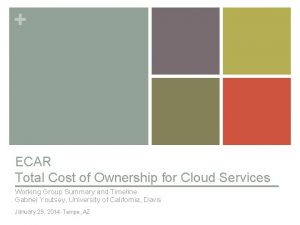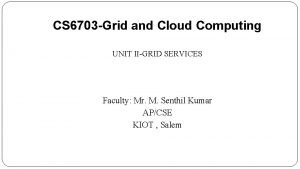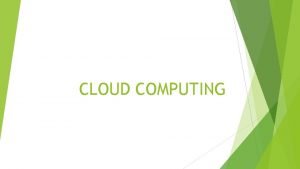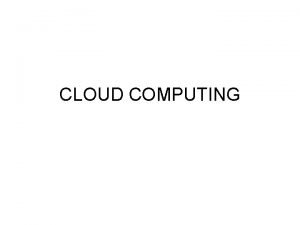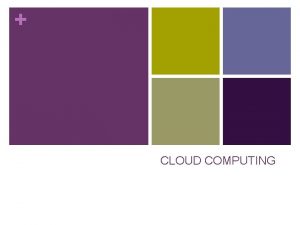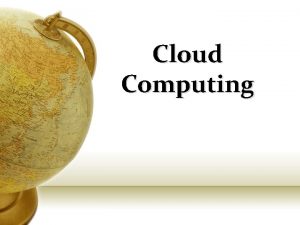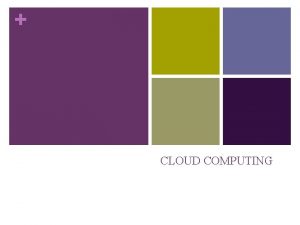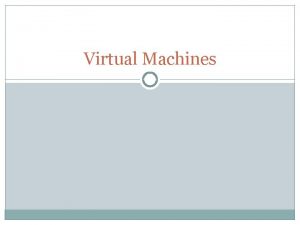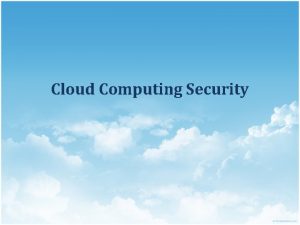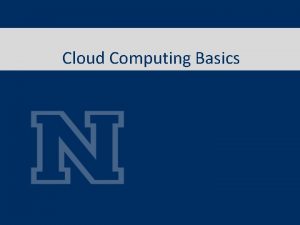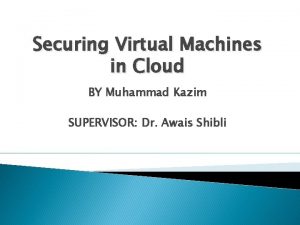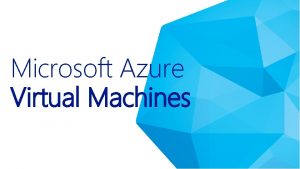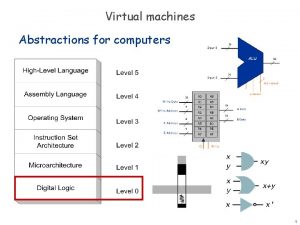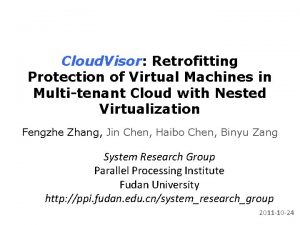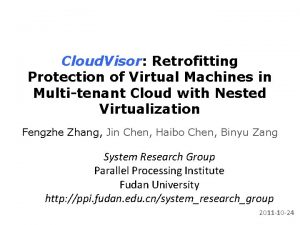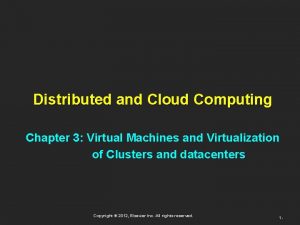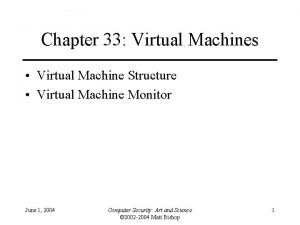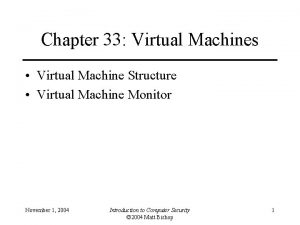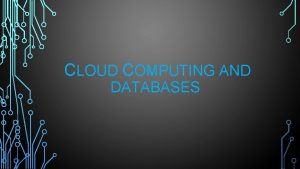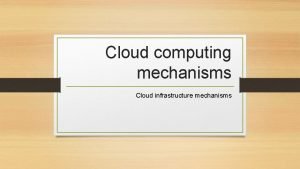Virtual machines image protection in Cloud computing Muhammad






























![References [1] Shubhashis Sengupta, Vikrant Kaulgud, Vibhu Saujanya Sharma, “Cloud Computing Security - Trends References [1] Shubhashis Sengupta, Vikrant Kaulgud, Vibhu Saujanya Sharma, “Cloud Computing Security - Trends](https://slidetodoc.com/presentation_image_h/114f247e54c705bf63d412c42ea9abe2/image-31.jpg)
![[6] Seongwook Jin, Jeongseob Ahn, Sanghoon Cha, and Jaehyuk Huh, “Architectural Support for [6] Seongwook Jin, Jeongseob Ahn, Sanghoon Cha, and Jaehyuk Huh, “Architectural Support for](https://slidetodoc.com/presentation_image_h/114f247e54c705bf63d412c42ea9abe2/image-32.jpg)
![[11] Zhi Wang, Xuxian Jiang, “Hyper. Safe: A Lightweight Approach to Provide Lifetime [11] Zhi Wang, Xuxian Jiang, “Hyper. Safe: A Lightweight Approach to Provide Lifetime](https://slidetodoc.com/presentation_image_h/114f247e54c705bf63d412c42ea9abe2/image-33.jpg)
- Slides: 33

Virtual machines image protection in Cloud computing Muhammad Kazim (2011 -NUST-MSCCS-23) Thesis Supervisor: Dr. Muhammad Awais Shibli G. E. C Members: Dr. Abdul Ghafoor Abbasi Dr. Hamid Mukhtar Ms. Rahat Masood

Agenda • Introduction • Motivation • Research Methodology • Problem Statement • Research Contributions • Implementation • Results • Conclusion

Introduction The core of Cloud services, Infrastructure-as-a-Service (Iaa. S) model provides the capability to provision; • Processing • Storage Iaa. S • Networks Paa. S Saa. S

Virtualization • In Cloud computing, Virtualization is the basis of providing Iaa. S. • A single system can concurrently run multiple isolated virtual machines (VMs), operating systems or multiple instances of a single operating system (OS). • Virtualization maximizes the jobs a single CPU can do. • Organizations are using virtualization to gain efficiency in platform and application hosting

Virtualization in Cloud Figure 1: Virtualization in Cloud

Virtual Disk Image • A single file or directory representing the hard drive of a guest operating system. • Encapsulates all components of a guest OS, including the applications and virtual resources used by guest OS. • Provides the ability to quickly launch and deploy virtual machines across various hosts.

Motivation • According to a survey, virtualization security is most important security issue in Cloud. • NIST, CSA and PCI DSS in their security guidelines for virtualization have emphasized the importance of virtualization and disk images security. • Disk images in storage can be compromised through attacks such as data leakage, malware installation on images and snapshot access in storage.

Problem Statement Virtual machine images are vulnerable to different attacks in Cloud storage. In order to secure virtual machines images from infrastructure, hypervisor and storage attacks, we have proposed a security mechanism that encrypts virtual machines images during storage.

Research Methodology Literature Survey Testing Problem Statement Framework Implementation Analysis of virtualization security Research Publication Design Framework Research Publication

Contributions • Theoretical (Two Research Publications) • Practical (Development of Open. Stack Disk Image Encryption framework)

Conference Paper 1 Muhammad Kazim, Rahat Masood, Muhammad Awais Shibli, Abdul Ghafoor Abbasi, “Security Aspects of Virtualization in Cloud Computing”, 12 th International Conference on Computer Information Systems and Industrial Management Applications, Krakow-Poland 2013, September 25 -27. http: //home. agh. edu. pl/~saeed/cisim 2013/

Conference Paper 2 Muhammad Kazim, Rahat Masood, Muhammad Awais Shibli, “Securing the virtual machine images in Cloud computing”, 6 th International Conference on Security of Information and Networks (SIN 2013), ACM, November 2628, 2013, Aksaray/Turkey. http: //sinconf. org/sin 2013/index. php

Virtual Machines Requirements Attacks Solutions Isolation between virtual machines should be properly implemented Malicious programs use Vigilant can monitor covert channels to faults in guest OS of VM communicate with other VMs in unauthorized way Update the OS regularly and use anti-virus software, secure internet and restrict remote access Malicious programs can monitor traffic, steal critical data, and tampering the functionality of VMs Securely boot the guest VMs Attacker can tamper boot Security protocol by J. process of guest VMs Kong can be to ensure secure boot of guest VMs There must be limit on VMs resource usage Using a malicious VM to consume extra resources of the system, resulting in DOS attack Security features such as firewall, HIPS, log monitoring must be provided in guest OS Administrator must deploy a software or application that limits VMs to use authorized resources

Disk Images Requirements Saved image state must not be tampered by hypervisor Attacks Solutions Attacker can compromise Use encryption and the integrity and hashing of images before confidentiality of the saved saving them state of image Snapshot access must be prevented from authorized VM checkpoint attacks access Checkpoint attacks can be prevented by encrypting the checkpoints using SPARC Apply updates and patches to maintain images secure Old images are vulnerable Nuwa is a tool designed to to zero day attacks apply efficient patching to VM images in Cloud Backup of the virtual machines images must be maintained Unauthorized access to the backup data can result in leakage of sensitive information Backup of VM images must be encrypted. If any VM is removed then its backup must also be removed

Implementation Perspective • Implement a framework that ensures confidentiality of images through encryption • Images are decrypted when required by the VM • Use of hashing techniques to ensure integrity

Open. Stack • Used in 178 different countries and more than 850 organizations including NASA, Rackspace, • Collection of open source components • Modular design • Iaa. S Cloud Services allows users to manage: VMs, Virtual networks, storage resources

Open. Stack Components • Swift • Glance • Nova • Horizon • Keystone • Quantum • Cinder

18 Virtual Machines in Open. Stack

Open. Stack Swift Architecture • Swift is a highly available, distributed, eventually consistent object/blob store. • Is maintained and developed by one of the largest open- source teams in the world, and is in the top 2% of all project teams on Ohloh. • Has 53, 605 lines of code and is written in Python.

Components • Proxy Servers: Handles all incoming API requests. • Rings: Maps logical names of data to locations on particular disks. • Accounts & Containers: Each Account and Container are individual databases that are distributed across the cluster. An Account database contains the list of Containers in that Account. A Container database contains the list of Objects in that Container • Objects: The data itself. • Partitions: A Partition stores Objects, Account databases and Container databases.

Image Encryption Module In Swift

Image Decryption Module In Swift

23 IEM & IDM& IEM IDM

Deployment of Open. Stack for development • Devstack • A documented shell script to build complete Open. Stack development environments. • Deployment of Devstack • Setup a fresh supported Linux installation • Clone devstack from devstack • Deploy your Open. Stack Cloud http: //devstack. org/

Debugging of source code • Debugging of Swift through command line ü Pdb (Python debugger)

Integration of Image Encryption and Decryption with Swift • Integrating Image encryption and decryption with Open. Stack Swift image storage. • Open. Stack Swift API is implemented as a set of Re. STful web services • The proxy server initiates an internal Swift PUT request to the object servers • Object servers processes images chunk by chunk so each chunk gets encrypted • Foe decryption object server decrypts each chunk before it sends the image to the proxy server

Demo • Running Devstack script • Add an image • Show it in Storage • Run a VM on it (it gets decrypted)

Results • Add a custom bootable image • Launch a VM • After VM termination, image is located into Swift encrypted • • storage After VM termination, image is stored in encrypted state in Swift. AES is block sized encryption, that adds extra padding to images Encryption of images maintains their confidentiality in Cloud storage Hash of image is taken before encryption. During decryption hash of image is calculated again, and compared with the original hash to ensure integrity of image.

Future Directions • Encryption of accounts to protect users and images lists in Swift. • Integration of Key Management protocol with Swift image encryption. • Encryption of persistent storage used by virtual machines during execution.

Conclusion • Image encryption module encrypts all virtual disk images before storage in Open. Stack. They are decrypted when required by the virtual machine. • Integrity and confidentiality of virtual machine images in storage is ensured. They are secure from all possible storage attacks such as data theft, malware installation and hypervisor issues.
![References 1 Shubhashis Sengupta Vikrant Kaulgud Vibhu Saujanya Sharma Cloud Computing Security Trends References [1] Shubhashis Sengupta, Vikrant Kaulgud, Vibhu Saujanya Sharma, “Cloud Computing Security - Trends](https://slidetodoc.com/presentation_image_h/114f247e54c705bf63d412c42ea9abe2/image-31.jpg)
References [1] Shubhashis Sengupta, Vikrant Kaulgud, Vibhu Saujanya Sharma, “Cloud Computing Security - Trends and Research Directions”, IEEE World Congress on Services, Washington, DC, USA, 2011. [2] Jakub Szefer, Ruby B. Lee, “A Case for Hardware Protection of Guest VMs from Compromised Hypervisors in Cloud Computing”, 31 st International Conference on Distributed Computing Systems Workshops, Washington, DC, USA, 2011. [3] Jinzhu Kong, “Protecting the confidentiality of virtual machines against untrusted host”, International Symposium on Intelligence Information Processing and Trusted Computing, Washington, DC, USA, 2010. [4] Farzad Sabahi, “Secure Virtualization for Cloud Environment Using Hypervisor-based Technology”, International Journal of Machine Learning and Computing vol. 2, no. 1, February 2012, pp. 39 -45. [5] Jenni Susan Reuben, “A Survey on Virtual Machine Security”, TKK T-110. 5290 Seminar on Network Security, 2007.
![6 Seongwook Jin Jeongseob Ahn Sanghoon Cha and Jaehyuk Huh Architectural Support for [6] Seongwook Jin, Jeongseob Ahn, Sanghoon Cha, and Jaehyuk Huh, “Architectural Support for](https://slidetodoc.com/presentation_image_h/114f247e54c705bf63d412c42ea9abe2/image-32.jpg)
[6] Seongwook Jin, Jeongseob Ahn, Sanghoon Cha, and Jaehyuk Huh, “Architectural Support for Secure Virtualization under a Vulnerable Hypervisor”, Proceedings of the 44 th Annual IEEE/ACM International Symposium on Microarchitecture, USA, 2011. [7] Ryan Shea, Jiangchuan Liu, “Understanding the Impact of Denial of Service on Virtual Machines”, IEEE 20 th International Workshop on Quality of Service (IWQo. S), Burnaby, BC, Canada, 2012. [8] Wu Zhou, Peng Ning, Xiaolan Zhang, “Always up-to-date: scalable offline patching of VM images in a compute cloud”, Proceedings of the 26 th Annual Computer Security Applications Conference, New York, USA, 2010, pp. 377 -386. [9] Trent Jaegar, Reiner Sailer, Yogesh Sreenivasan, “Managing the Risk of Covert Information Flows in Virtual Machine Systems”, Proceedings of the 12 th ACM symposium on Access control models and technologies, New York, USA, pp. 81 -90, 2007. [10] Mikhail I. Gofman, Ruiqi Luo, Ping Yang, Kartik Gopalan, “SPARC: A security and privacy aware Virtual Machine checkpointing mechanism”, Proceedings of the 10 th annual ACM workshop on Privacy in the electronic society, New York, USA, 2011, pp. 115 -124.
![11 Zhi Wang Xuxian Jiang Hyper Safe A Lightweight Approach to Provide Lifetime [11] Zhi Wang, Xuxian Jiang, “Hyper. Safe: A Lightweight Approach to Provide Lifetime](https://slidetodoc.com/presentation_image_h/114f247e54c705bf63d412c42ea9abe2/image-33.jpg)
[11] Zhi Wang, Xuxian Jiang, “Hyper. Safe: A Lightweight Approach to Provide Lifetime Hypervisor Control-Flow Integrity” IEEE Symposium on Security and Privacy, Oakland, CA, USA, 2010, pp. 380 -385. [12] Mohamad Rezaei et al. , “TCvisor: a Hypervisor Level Secure Storage”, Internet Technology and Secured Transactions (ICITST), London, 2010, pp. 1 -9. [13] Dan Pelleg, Muli Ben-Yehuda, Rick Harper, “Vigilant—Out-of-band Detection of Failures in Virtual Machines”, ACM SIGOPS Operating Systems Review, New York, NY, USA, Volume 42 Issue 1, 2008, pp. 26 -31. [14] Sandra Rueda, Rogesh Sreenivasan, Trent Jaeger, “Flexible Security Configuration for Virtual Machines”, Proceedings of the 2 nd ACM workshop on Computer Security Architectures, New York, NY, USA, 2008, pp. 35 -44. [15] Koichi Onone, Yoshihiro Oyama, Akinori Yonezawa, “Control of System Calls from Outside of Virtual Machines”, Proceedings of the 2008 ACM symposium on Applied Computing, New York, NY, USA, 2008, pp. 2116 -2221.
 Seven step model of migration into cloud
Seven step model of migration into cloud Machine image in cloud computing
Machine image in cloud computing Wa ta izzu man tasha meaning in urdu
Wa ta izzu man tasha meaning in urdu Allahumma salli ala muhammad wa ala ali muhammad
Allahumma salli ala muhammad wa ala ali muhammad Real vs virtual images
Real vs virtual images Real vs virtual images
Real vs virtual images Pentesting virtual machines
Pentesting virtual machines Virtual machines
Virtual machines Conventional computing and intelligent computing
Conventional computing and intelligent computing Vodafone data hosting
Vodafone data hosting Full virtualization in cloud computing
Full virtualization in cloud computing Tools and mechanisms for virtualization
Tools and mechanisms for virtualization Stratus clouds
Stratus clouds Cloud computing reference model
Cloud computing reference model Ardc nectar
Ardc nectar All resources are tightly coupled in computing paradigm of
All resources are tightly coupled in computing paradigm of Multi-device broker
Multi-device broker Green cloud computing ppt
Green cloud computing ppt Scalability issues in cloud computing
Scalability issues in cloud computing Conclusion of cloud computing
Conclusion of cloud computing Unified management software in cloud computing
Unified management software in cloud computing Nist cloud computing architecture
Nist cloud computing architecture Nimbus architecture in cloud computing
Nimbus architecture in cloud computing Cloud computing cambridge
Cloud computing cambridge Case study on microsoft azure in cloud computing
Case study on microsoft azure in cloud computing Cloud computing layers
Cloud computing layers Regarder introduction to cloud computing
Regarder introduction to cloud computing Sejarah cloud computing
Sejarah cloud computing Kentico cloud
Kentico cloud Cloud computing tunisie
Cloud computing tunisie Permissive federation in cloud computing
Permissive federation in cloud computing Cloud computing paradigm
Cloud computing paradigm Total cost of ownership in cloud computing
Total cost of ownership in cloud computing What is ogsa
What is ogsa

